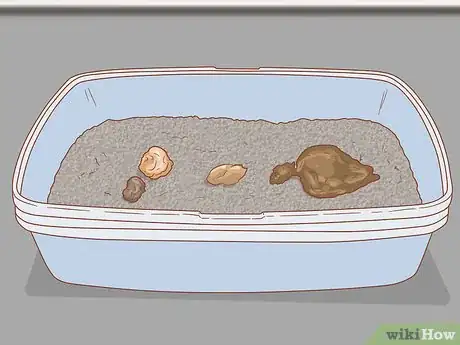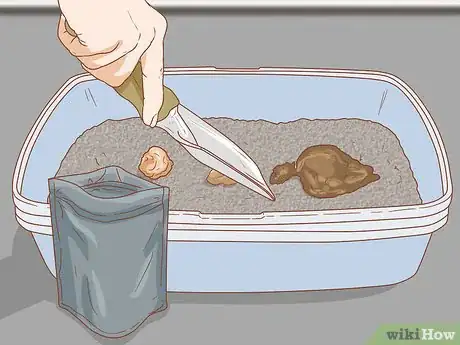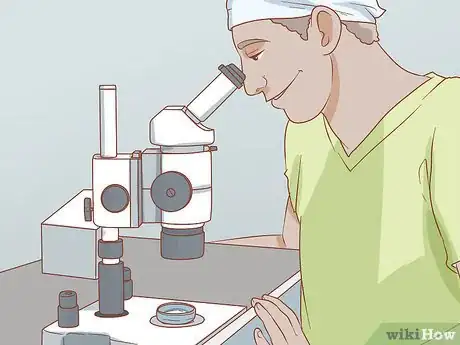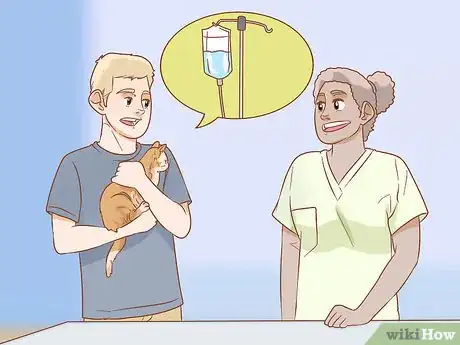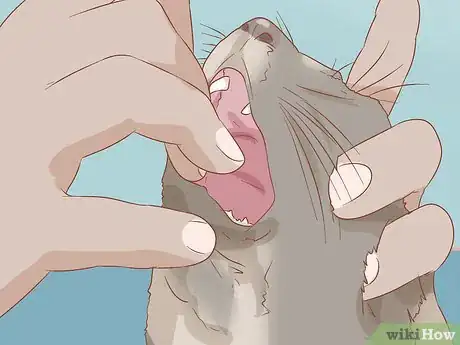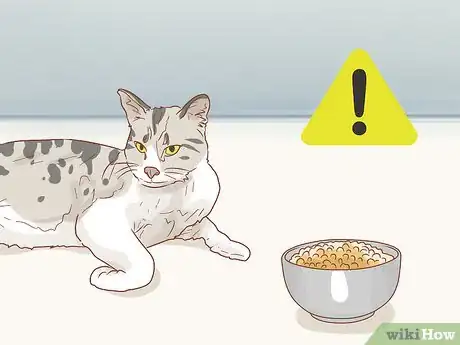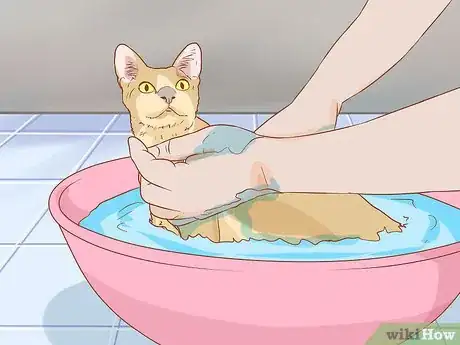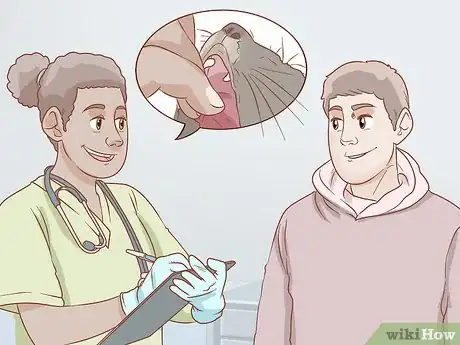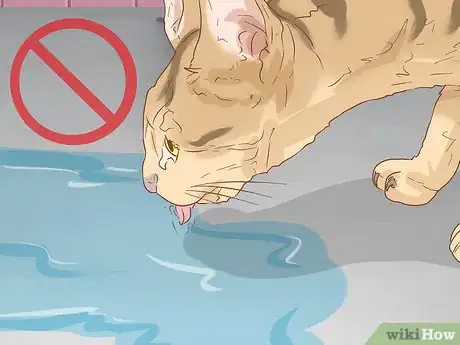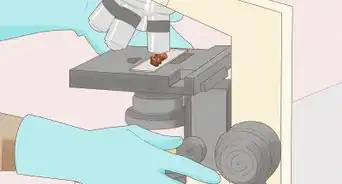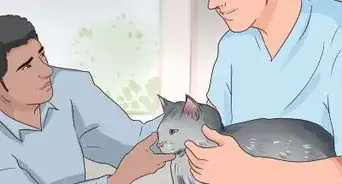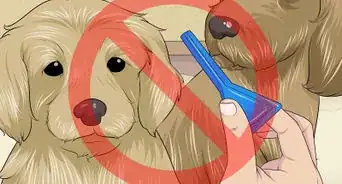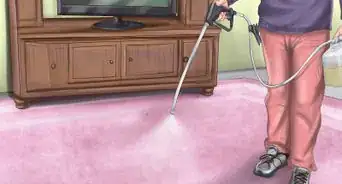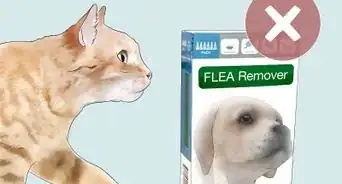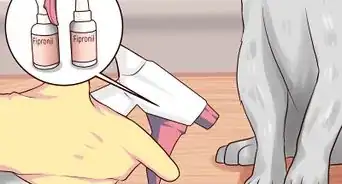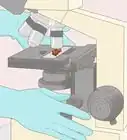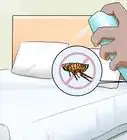This article was co-authored by Deanne Pawlisch, CVT, MA. Deanne Pawlisch is a Certified Veterinary Technician, who does corporate training for veterinary practices and has taught at the NAVTA-approved Veterinary Assistant Program at the Harper College in Illinois and in 2011 was elected to the board of the Veterinary Emergency and Critical Care Foundation. Deanne has been a Board Member of the Veterinary Emergency and Critical Care Foundation in San Antonio, Texas since 2011. She holds a BS in Anthropology from Loyola University and an MA in Anthropology from Northern Illinois University.
This article has been viewed 26,958 times.
Giardia is an infection of the intestines caused by a parasites. If cats drinks contaminated water or ingests cysts from other animals infected with the giardia parasite, they can develop an infection. To diagnose giardia, keep a close eye on your cat and watch for symptoms such as changes in bowel movements. If you notice giardia symptoms, take your cat to a vet's office for an official diagnosis. Giardia is usually easily cleared up with medication.
Steps
Seeking a Diagnosis
-
1Watch for changes in bowel movements. If you want to diagnose giardia, pay attention to your cat's litter box. The main sign of giardia is unusual bowel movements. Cats will have foul-smelling, watery diarrhea that may contain trace amounts of blood.[1]
- Some cats may also lose weight with giardia due to the diarrhea. Cats may also become less active in this weakened state.
-
2Explain your cat's symptoms to your vet. If you notice any unusual symptoms, take your cat to the vet right away. The vet will work with you to diagnose and treat giardia. Tell the vet all the symptoms you observed and they will determine whether to test your cat for giardia.[2]
- The symptoms of giardia do not necessarily indicate giardia. Unusual bowel movements can be caused by lifestyle changes, such as a change in diet.
Advertisement -
3Collect a stool sample. Giardia infections are usually detected via a stool sample. Collect a recent stool sample from your cat's litter box for testing. Place the stool sample in a plastic bag and bring it to your vet's office for testing.[3]
- Fecal testing should be done on an annual basis in addition to times when you think your cat may be ill.
-
4Have your vet test the sample. Your vet will send the sample to a lab or test it in the clinic. The test will determine if your cat has giardia.[4]
- A stool sample is usually used to detect giardia. However, depending on your cat's symptoms and risk factors, vets may occasionally diagnose giardia without a stool sample.
Treating Your Cat's Symptoms
-
1Hospitalize your cat if necessary. Usually, giardia can be treated at home. However, the condition can cause dehydration. If your cat is severely dehydrated, your vet may want to leave your cat at the hospital so it can receive fluids via an IV.[5]
-
2Provide the necessary medications. Giardia is usually treated through prescription medications. Your vet may administer the medications at the office. They may also send you home with medications for your cats. Your vet will provide information about how often and for how long to give your cat medications to fight giardia.[6]
- Metronidazole is the medication most often prescribed. Unless your cat is pregnant, your vet will likely give you a prescription for metronidazole.
- Pregnant cats are usually treated with the alternative medication fenbendazole.
-
3Monitor your cat for signs of dehydration. Younger cats and kittens are especially prone to developing dehydration due to giardia. Dehydration can be life-threatening when left untreated. If you notice signs of dehydration in your cat, take it to your vet as soon as possible.[7] The following are symptoms of dehydration in cats:[8]
- Sunken eyes
- Lethargy
- Stiff skin
- Dry mouth
- Lack of appetite
Preventing a Reoccurrence
-
1Bathe your cat. Use pet shampoo to bathe your cat to ensure no traces of fecal matter are left on their coat. This can help prevent giardia from spreading to other pets in the house as well as to humans. It can also keep your cat from getting reinfected after taking medications.[9]
-
2Administer regular medication to outdoor cats. If your vet suggests it you can administer medication for giardia regularly to outdoor cats. The medication is not harmful for cats who do not have giardia and it can help stop an infection right away. Ask your vet whether regularly giving your cat giardia-fighting medications is right for you.[10]
-
3Limit access to outside water. Giardia can be ingested through water from creeks, lakes, and ponds. Keep your cat inside for the most part, especially if you live near a body of water. Your cat should only drink clean tap water to prevent giardia.[11]
References
- ↑ https://vcahospitals.com/know-your-pet/giardia-in-cats
- ↑ https://www.vetary.com/cat/condition/giardiasis
- ↑ https://vcahospitals.com/know-your-pet/giardia-in-cats
- ↑ https://vcahospitals.com/know-your-pet/giardia-in-cats
- ↑ https://www.vetary.com/cat/condition/giardiasis
- ↑ https://www.vetinfo.com/treating-giardia-cats.html
- ↑ https://www.vetary.com/cat/condition/giardiasis
- ↑ http://www.cathealth.com/how-to/dehydration-in-cats-how-can-you-tell-if-a-cat-is-dehydrated
- ↑ https://www.cdc.gov/parasites/giardia/prevention-control-pets.html
About This Article
If you’re unsure if your cat has giardia, check its stools for foul-smelling, watery diarrhea, which may also contain traces of blood, since this is the most common sign. Take your cat to the vet as soon as possible if you notice any unusual symptoms for a diagnosis. Bring a stool sample with you so your vet can test it. If your cat has giardia, your vet will usually treat it with medication. However, if your cat is severely dehydrated, they may give it fluids through an IV. Once your vet has discharged your cat, follow their instructions for any further medication to treat your cat effectively. If you notice any signs of dehydration, such as sunken eyes, lethargy, a dry mouth, and lack of appetite, take your cat back to the vet as soon as possible, since dehydration can be dangerous. For more tips from our Veterinary co-author, including how to prevent a recurrence of giardia, read on!
